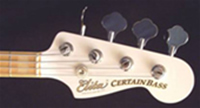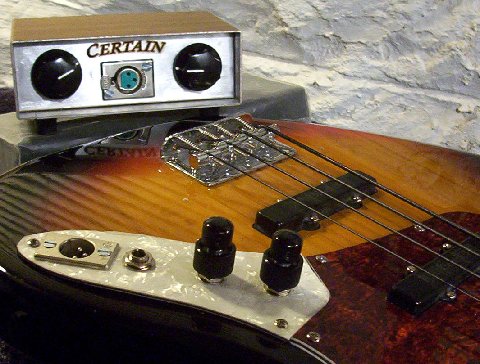
STEREO BASS
 |
STEREO BASS |
| The Case for Stereo Bass:
ďStanley's usual live signal path is split between bridge and neck pickups. From there signals go into a power supply/preamps (one per pickup), to a Mackie 1202 mixer then into two QSR RMX 2450 power amps, which drive two SWR Goliath III 4x10 cabinets (from the bridge-pickup signal) and two SWR Big Ben 1X18 subwoofer cabinets (the neck-pickup signal). He usually uses a Fender Twin guitar amp, for a bit of grit and crunch; this is driven by the bridge-pickup preamp.Ē With the Alembic, he also has the Alembic onboard EQ for each pickup to do even more stuff from right on his bass. While, as we will see, some let the house mixer mix the two signals, Stan does it himself from the bass (probably keeping the house engineer on his toes). Most local bassists have not discovered that most of the leading bassists use two amplifiers. As an aside: most working class, gigging bassists are thinking light weight, small. Sorry, but you canít fool Mother Nature. Bass means big. It comes with the territory. To produce bass you need to push some air. Two 18ís, three 15ís or 6 10ísÖ itís all about the same. Itís about square inches of cone area. Thatís why an SVTís eight tens will best two eighteens notwithstanding frequency response. And thatís why people see me hauling around some horrendous, huge amplification. We must fill the hall with warmth. Itís not about cutting with volume, itís about cutting with tone. Letís get back to some more of our leading bassists and what they do for amplification, and weíll notice a very important pattern. Although they donít split the pickups as Chris Squire and Stanley Clarke do, they still split the bassís mono signal to two places, a clean one and a dirty one, to be mixed at the board. If youíre playing shows where there is sound, itís easy to achieve the sound by taking a direct line off your bass before the amp, then micíing the amp, the skankier the better, then letting the sound guy mix them. How about Geddy Lee? Heís all about a fat bass tone. Again, the theme of a clean amp and a dirty amp. From Wikipedia, ďLee's amps in the early days were arena-ready Sunn and/or Ampeg models. By the late seventies, his backline had evolved into a configuration of Ashly preamps and BGW power amps, which were run in stereo with his 4001 bass. The neck pickup was sent to one amp and set for a clean, bass-heavy tone, while the bridge pickup was sent to the other amp which was set with an exaggerated treble boost, and extra gain in the preamp. This defined Lee's bass sound from 1977 to 1982. Though he would change basses, the amplifier setup remained constant through 1991.Ē What Mr. Lee does today: ďAt the beginning of the 2002 Vapor trails tour, Lee revised his previous setup. His bass signal is sent via a Samson wireless unit to an Avalon U5 DI. From there it is split between a Trace Elliot Quadravalve all-tube power amplifier and a SansAmp RBI rackmountable preamp. The speaker-level signal from the Quadravalve is sent to a Palmer PD-05 speaker emulator, which provides adequate load for the tube amplifier and attenuates the signal down to line level. The signals from the U5, Quadravalve/PD-05, and RBI are all sent to the monitor and front-of-house mixers and blends of the signals are changed on a song-by-song basis. Typically the Quadravalve/PD-05 signal makes up the low end while a balance of the U5 and RBI make up the high end, with the RBI providing the "top end" distortion in Lee's sound. Letís look at Sting: he has his old early 50ís basses and replicas he tours with, one pickup, mono output. But hereís what they do for him amp-wise: ďFrom the basses, Shure U1-UA wireless UHF transmitters are routed through a switching/muting system. From the switcher, the signal goes to an Alembic F1-X preamp and then into a Court Acoustics GE60 i-octave equalizer and a Urei 7110 compressor/limiter before going to an Electro-Voice XEQ-3 crossover and on to the amplification. Bass signals to the front of house come from two direct outs: one from the Shure wireless and a second from the Alembic preamp with the preamp out located after the EQ.Ē Notice the concept is still about getting a clean, full range signal and a second warmed up signal with something tube-y, then mixing them separately. The engineer blends these two signals just like I can do from the cockpit of my stereo bass. Incidentally, the Alembic F2-B preamp is essentially a Fender Showman preamp. Thereís the skank and squawk. So this is the kind of stuff Iíve been developing along with my Varitone. My system has two Varitones, one for each side. They can be onboard or in a box. Hereís how it works: for your clean system use the neck pickup and positions 5 or 6 on the Varitone for a midrange dip. Roll off treble if you want to kill the metal on top. Get that singing. Now turn it down. Now turn up the bridge pickup and use positions 2, 3 or 4 for high end roll-off. Get a squawky sound, think Jaco. Now blend the two. Itís Marcus and Jamerson in the same room, one or the other or both blended. Your neck pickup is like the clean, pristeen thing while the bridge pickup has different brands of skank and squawk. Use that as a presence control. Now, try putting the bridge pickup on 5 or 6 and the neck pickup on 2,3 or 4. Itís a different bag but still in the realm of reasonabloe EQ. Theyíre tone character changes. These are the secrets to the bass tone youíre looking for. There are two worlds, and weíre doing the best of both and blending them. So you donít want to haul around two amps? You can use my system with great results with a two channel bass head (which is pretty much a thing of the past). A Fender Showman head (which is a better bass head than the Bassman was) works great as does my Kustom 200. SVT has two channels although just one master EQ. Or you can use a stereo graphic EQ. But even if you use my stereo with dual Varitone system into one input, youíre still voicing each pickup separately. And you can still play the pristeen vs. skank game.  I think XLR at the bass is the way to go too, unless you have to bastardize a vintage instrument. This allows one to use just a regular mic chord between the bass and the box. If we take a stereo 1/4 inch jack and put it on a mic cable, then we don't have to modify your vintage bass. But while we're using a box, we might as well put some goodies in it. There's this company called CertainBass that has some hip stuff....OK, I can't hold back the surprise anymore. Stereo bass. Twin Varitones. 
On the back panel you have two lefts and two rights and either can be inputs or outputs. Notice the 1/4 inch jack on the bass. That's for back up. You can plug in one side of the box and use a normal guitar cable. The nice thing about my set-up is it utilizes readily available cables. |